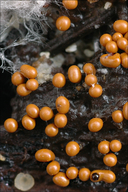|
|
click photo for larger file

Hemitrichia clavata
Yellow-fuzz Cone Slime
|
Photographer: Dr. Amadej Trnkoczy
ID: 0000 0000 0918 0263 (2018-09-04)Copyright © 2018 Dr. Amadej Trnkoczy
|
|
INFORMATION PROVIDED WITH THE PHOTO
|
date of photo Oct 5, 2009
latitude 46.33439 longitude 13.48114
View on Google Maps.
location
Bovec basin, Gozdec forest, above the road from Mt.Kanin cable car station B to the foot of Mt. Kopa, East Julian Alps (Posočje, Slovenia)notes Slo.: kitajska zlatovka - syn.: Trichia clavata Pers., Hyporhamma clavatum (Pers.) Lado - Habitat: Mixed, predominantly Fagus sylvatica forest, in shade, partly protected from direct rain by tree canopies, average precipitations ~3.000 mm/year, average temperature 3 -5 deg C, elevation 1.330 m (4.400 feet), alpine phytogeographical region. Substratum: fallen, heavily rotted trunk of a deciduous tree, probably Fagus sylvatica. Comment: There was no microscopy done for this observation, hence the determination is unreliable. Myxomycetes pass through very different shapes and colors during development of their sporocarps. In most cases it is impossible to determine them to species level without microscopic observation of their spores and structure, at least for me. These pictures show immature sporocarps. Sporocysts have not yet opened, capillitium and spore mass are not yet visible. Also stalks are mostly not yet developed. This makes determination even more difficult. Nevertheless, the size and the shape of the oldest sporocarps and stalks with reddish tint points toward Hemitrichia clavata. But, it is possible that the pictures show other Hemitrichia or Trichia species like similar Trichia decipiens or Hemitrichia calyculata. Picture #10 shows eventually another species. On picture #8 one can see also two species of (probably) Ascomycetes - a larger jelly fungus and smaller black blobs (both lower left). What a picturesque life one can find just on a small piece of rotten wood! A white 'mycelium' shown on the same picture (and others - upper left) probably belongs to another kind of fungus. Although Hemitrichia clavata has white plasmodium these fibers don't seem to me to be its plasmodium. Ref.: (1) B. Ing, The Myxomycetes of Britain and Ireland,The Richmond Publ. Co.Ltd, (1999), p 127. (2) S.L.Stephenson and H.Stempen, Myxomycetes, Timber Press Inc.(2000), p 124. (x) M. Poulain, M. Meyer, J. Borronet, Les Myxomycetes, FMBDS (2011), Vol.1., p 371; Vol.2. p 130. (3) S. Behrič, Raznolikost Pravih Sluzavk (Myxomycetes) v okolici Mengeša, (in Slovene) (True Slime Molds (Myxomycetes) Diversity in the Vicinity of Mengeš), Graduation thesis, University Studies, University in Ljubljana, Biotechnical Faculty, Biology department (2015), p 86. (4) H. Neubert, W. Nowotny, K. Baumann - H. Marx, Die Myxomyceten Deutschlands und des angrenzenden Alpenraumes unter besonderen Berücksichtigung Österreichs, Vol.2.,Karlheinz Baumann Verlag, (1993, 1995, 2000), p 232.camera Nikon D70 / Nikkor Micro 105mm/f2.8
contributor's ID # Bot_388/2009_DSC5885 photo category: Fungi - mold
|
MORE INFORMATION ABOUT THIS FUNGUS
|
| common names
Yellow-fuzz Cone Slime (photographer)
View all photos in CalPhotos of Hemitrichia clavata Check Google Images for Hemitrichia clavata |
|
The photographer's identification Hemitrichia clavata has not been reviewed. Sign in to review or comment on this photo |
|
Using this photo The thumbnail photo (128x192 pixels) on this page may be freely used for personal or academic purposes without prior permission under the Fair Use provisions of US copyright law as long as the photo is clearly credited with © 2018 Dr. Amadej Trnkoczy.
For other uses, or if you have questions, contact Dr. Amadej Trnkoczy amadej.trnkoczy[AT]siol.net. (Replace the [AT] with the @ symbol before sending an email.) |
|
|
